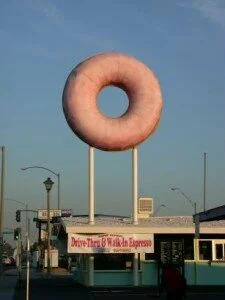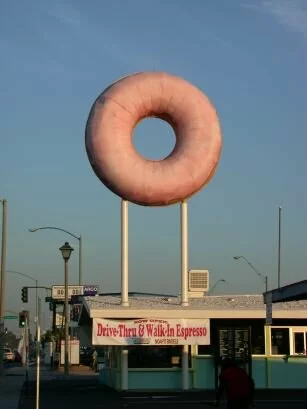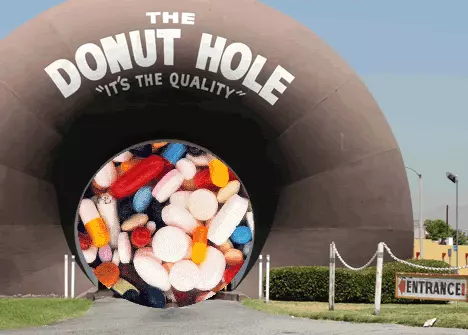 We’ve written here frequently about the “doughnut hole” in Medicare Part D. This is a coverage gap that, in 2009, requires seniors to begin paying full price for their prescription drugs if they exceed $2,700 in total drug costs.
We’ve written here frequently about the “doughnut hole” in Medicare Part D. This is a coverage gap that, in 2009, requires seniors to begin paying full price for their prescription drugs if they exceed $2,700 in total drug costs.
Contrary to what many seniors believe, the $2,700 isn’t based on out-of-pocket expenditures, but the total cost of their drugs, including the covered portion. So a senior will typically pay less than $1,000 out of pocket before hitting the coverage gap.
And here’s where the doughnut hole becomes a chasm. Coverage doesn’t kick in again until the senior has paid a whopping $4,350 out of pocket.
About a quarter of Medicare Part D enrollees — more than six million seniors — fell into the doughnut hole in 2008.
Now a new study says that many Medicare recipients are choosing not to take their prescription medications once they hit the gap. According to researchers at the University of Pittsburgh Graduate School of Public Health, seniors reduced their monthly prescription drug purchases by 14 percent when their coverage went away.
Doctors fear that patients with chronic conditions such as diabetes and hypertension are putting their health at risk by not taking needed medications.
Clearly, something needs to be done. Unfortunately, the Medicare Part D plan is so expensive — because the legislation that created it was basically drafted by the pharmaceutical industry — that simply throwing more money at the program is not the best solution. What needs to be done first is to pass legislation allowing Medicare to negotiate drug prices with Big Pharma (just as the Veterans Administration does). That would reduce the government’s costs sufficiently to close the coverage gap altogether.
You can read a helpful primer on the doughnut hole, featuring 2009 numbers, here.
Consumer Reports says buying prescription drugs from Canada can be a smart strategy for cost-conscious consumers. Here’s the magazine’s advice:
You can often save 25 percent or more [using mail-order pharmacies]. Buying brand-name medications from Canada can boost your mail-order savings, sometimes up to 50 percent. Generics, however, are cheaper in the U.S. And drugs bought in Canada will not count toward your Medicare Part D deductible.
While it’s illegal to buy drugs from foreign countries, including Canada, because of safety concerns, the FDA may refrain from taking legal action if you can provide your doctor’s name, address, and phone number, and confirm that the drugs are for personal use.
If you wish to explore this option, look for pharmacies with the Canadian International Pharmacy Association seal. Go to eDrugSearch.com, to get safe access to affordable medications from licensed online pharmacies, for the highest-rated sites.
We’d clarify that while some generics are cheaper through U.S. online pharmacies (which is one reason we include U.S. pharmacies in the eDrugSearch.com system), others are not.
As eDrugSearch.com members know, the Canadian International Pharmacy Association (CIPA) and PharmacyChecker.com are both friends of eDrugSearch.com. All eDrugSearch.com member pharmacies are required to have PharmacyChecker.com approval, and most also have the CIPA seal. You can learn more about our pharmacy approval process here.
About this Angie’s List Expert: Cary Byrd is the president and founder of eDrugSearch.com. Based in San Antonio, eDrugSearch.com is a free cost comparison engine that helps consumers get safe access to affordable medications and advocates licensed online pharmacies as a widely accepted alternative.
BusinessWeek published a story this week on “Medicare’s Costly Doughnut Hole,” which mostly rehashes a survey from the Kaiser Family Foundation (reported here previously) that shows many seniors forgo needed medications rather than pay full price for their meds.
The story also reports that the doughnut hole is getting bigger…
The doughnut hole is exacerbating a growing Medicare financial burden on seniors. On Sept. 26, health-care advisory firm Avalere Health released a report predicting Part D beneficiaries will see their premiums rise 24% on average, to $37 a month, in 2009. Those who joined the 10 most popular plans will swallow a 30% increase … Some drug companies offer assistance programs, Fletcher says, but only for the lowest-income seniors, and only for those willing to endure a tough application process. Those who watch Part D carefully worry that some patients may be cutting back on their drug intake altogether to avoid the doughnut hole, even if they’re endangering their health by doing so.
…and that Obama or McCain may have a chance, if not to fill the hole, then to at least reduce its size for some or all Medicare recipients:
Health policy experts believe that the next Administration will be under pressure to address the doughnut hole, and both candidates have expressed some support for reforming the program. Senator Barack Obama (D-Ill.) endorses the idea of letting the government negotiate drug prices for Part D (it doesn’t have the right to do so now). Senator John McCain (R-Ariz.) has said that higher-income beneficiaries should pay higher premiums for their Part D plans.
Both ideas—dropping drug prices and shifting more of the up-front premiums to members who can afford to pay—have been bandied about in Washington as potential ways of at least shrinking the doughnut hole without the government having to pony up more to support Part D. The prospect of a $700 billion bailout of the financial industry is certainly taking attention away from health-care reform, but there is little doubt the next President will place the doughnut hole high on his agenda.
We talk a lot on this blog about the 65 million Americans without prescription drug insurance, and the millions of additional seniors who fall into the Medicare doughnut hole every year. But for those of you fortunate enough to have an employer-sponsored health insurance plan, we know that life isn’t a bowl of cherries for you, either.
As Sandra Block writes at USA Today:
The average employee’s health care costs, including premiums and out-of-pocket expenses, will increase 8.9% in 2009, according to Hewitt Associates. That’s well above the rate of inflation and average salary increases… For that reason, it’s more important than ever to scrutinize your employer’s health care options during open enrollment season. Don’t assume the plan you used last year is still the best choice…
Specifically, when it comes to prescription drugs, Block advises:
1. If you’re moving to a plan that offers “co-insurance” rather than co-payments for prescription drugs, prepare for your costs to go up.
Many employees are accustomed to making co-payments of $5 to $25 for everything from prescription drugs to doctor’s visits. But increasingly, employers are replacing co-payments with co-insurance in an effort to control costs, particularly for prescription drugs … Under a typical co-insurance model, Abbott says, a plan may cover 90% of the cost for a generic drug, 75% for a brand-name drug that’s on the plan’s preferred list and only 50% of the cost of a non-preferred brand-name drug.
Co-insurance is designed to reduce the cost of prescription drugs by encouraging workers to use generic drugs or the lowest-cost brand-name drugs. Some plans have adopted a hybrid formula that charges a flat co-payment for generic drugs and co-insurance for brand-name drugs … If you’re accustomed to paying $10 or $15 every time you fill a prescription, a switch to co-insurance could raise your out-of-pocket costs … You can save money by using generic drugs whenever possible.
2. Use the provider’s mail-order option for buying drugs.
Most plans offer mail-order delivery of prescription drugs, and these programs can save you a lot of money … Because you’ll receive a larger supply “typically 90 days” you’ll save money on co-payments, she says. You may receive a discount on the price of the drugs, too.
3. Consider contributing to a flexible spending account or health savings account if it’s offered.
Most employers offer flex accounts, which let you use pretax dollars to pay out-of-pocket medical and dental costs. These accounts can help reduce the cost of co-payments, co-insurance and deductibles, but less than a quarter of workers contributed to an FSA in 2008 … You must decide when you enroll in your plan how much you want to contribute during the year.
Of course, the reason most people don’t use flex accounts or health savings accounts is that if you don’t end up using the money you’ve contributed during the plan year, you lose it. So I’d advise you only to use these accounts if there is a predictable level of out-of-pocket expenses that you end up hitting year after year.
Those who would minimize the crisis that is the U.S. healthcare system would have you believe, among other things, that the problem of high-priced prescription drugs mostly affects the elderly — who supposedly have gotten the relief they need from Medicare Part D and a multitude of state programs.
This is simply not the case.
The Los Angeles Times reports on a pharmacy benefit manager’s study that states:
…nearly 70 percent of adults aged 25-34 claim the economic downturn of the last 12 months has made it somewhat or significantly more difficult to pay for health care expenses … Overall, three out of four people are concerned about the cost of health care…
The Times speculates as to the reasons for increasing concern among young adults:
A couple of things might be going on with young adults. First, problems like diabetes and heart disease are hitting younger people these days, connected to the growing rates of overweight and obesity among younger Americans, so more of them are taking prescription drugs than in the past. And second, young people are hit with economic hard times when they may still be paying off college loans and beginning to set up independent lives with their own rent, mortgages or car payments.
Older prescription drug users are more savvy about asking their physicians for cheaper, generic versions of drugs, and to use mail-order pharmacies to save money, according to the survey.
So it seems that everyone is worried, and youth itself doesn’t necessarily let people off the hook.
Amen to that. Many eDrugSearch.com members are seniors, for the reasons the Times post states — they are savvier consumers. They have had to search for ways to cope with the issue of skyrocketing prices for years, because a sizable percentage of seniors take five or more different prescription drugs per day.
Young people are much more likely to take only one or two prescription medications regularly. But prices are now so high that even that can bust a budget, especially if one of those drugs has been dropped from an insurer’s co-pay list.
To cite an example I gave earlier this year:
I have a friend on an oral chemotherapy drug who, despite being fully insured through her employer, was still forced to pay thousands of dollars for her medication. Needless to say, this came as a shock to her. It’s hard enough to go through chemo without having to pay thousands of dollars for a few bottles of pills.
Insurers keep moving the goalposts on the definition of “being covered” in this country. Standards of coverage pale in comparison to what they were 20 or even 10 years ago. And yet the premiums continue to increase far more rapidly than the inflation rate.
From the Sarasota Herald-Tribune:
In health care circles, Monday is Doughnut Hole Day, the deceptively storybook name for a nasty plot turn in the drama of getting prescriptions filled when you’re over 65 and living close to the bone. The hole is the gap in coverage built into Medicare’s Part D prescription drug program, which pays most of the first $2,250 in patient prescriptions and 95 percent of drug expenses over $5,850.
Doughnut Hole Day is the point on the calendar at which large numbers of people with chronic illness begin to exceed $2,250 in drug costs, leaving them to pay full price for their prescriptions until they have spent $3,600 out of pocket.
An August Kaiser study showed that one in four seniors fall into the doughnut hole each year, and that many stop taking needed medications as a result.
What, if anything, do the presidential candidates plan to do about the Medicare doughnut hole?
Here’s one analyst’s take on John McCain’s position:
McCain was absent on the vote to repeal the Bush administration ban on government use of its bulk purchasing power to negotiate lower prices from drug companies for Medicare recipients. He’s been silent on the doughnut hole, under which seniors must pay 100 percent of the next $3,000 in drug costs after Medicare pays 75 percent of cost for the first $2,700, and mum on insurance industry price gouging in the Medicare Advantage program in which payments to private plans average 113% of the cost of care for comparable seniors in regular Medicare.
Obama, meanwhile, has stated that he would close the doughnut hole if elected.
Of course, with the economy a mess and the federal government spending upwards of a trillion dollars to bail out the financial services industry, an Obama administration would have a hard time mustering support for new government spending to help out seniors.
So Doughnut Hole Day is probably here to stay for a while — and, in fact, is predicted to begin coming earlier in the year, as the Medicare coverage gap is expected to increase without federal intervention.
The Dallas Morning News has a worthwhile story on “doughnut hole season” here.
Image source
We all know — or should know — by now that the Medicare prescription drug benefit (Medicare Part D) was crafted with the needs and convenience of Big Pharma, rather than patients, in mind. That’s why it’s so unwieldy for the consumer.
The worst part about Medicare Part D is the so-called “doughnut hole,” described by the Wall Street Journal as “the notorious gap in coverage … where (beneficiaries) generally must begin paying the full cost of their medicines. The doughnut hole kicks in when total drug expenditures by the beneficiary and the plan reach $2,510.”
Another egregious element of Medicare Part D, which has gotten less attention, is private “pharmacy benefit managers” charging Medicare beneficiaries MORE for prescription drugs than they cost at the pharmacy! These middlemen are ripping all of us off, too, since the taxpayers are picking up most of the tab. And by charging inflated prices, they push Medicare beneficiaries into the doughnut hole sooner.
Medicare is trying to fix the problem, but in the meantime, advocates for the elderly are advising them to buy at least some of their drugs outside the Medicare Part D plan.
Advises the Wall Street Journal:
Medicare drug-benefit participants buying drugs should consider checking low-price sellers of generic medications, such as Costco Wholesale Corp. and Wal-Mart Stores Inc., to see if their retail prices are lower than those in the insurance plan.
That is what Len Steinberg of Scottsdale, Ariz., did, and he found that Costco’s retail price for his generic nasal spray was about half of the drug’s total cost under his plan.
Mr. Steinberg, a 73-year-old retired employee-benefits consultant, says he now pays cash for certain cheap generics at Sam’s Club and Costco, rather than using his drug coverage. That allows him to avoid the doughnut hole and continue receiving coverage for his more expensive branded medications, he says.
Another option, of course, is to buy your medications from licensed Canadian pharmacies, where prices are on average about 50 percent less than the same drugs at U.S. pharmacies.
Image source: Senior Focus
-
 Subscribe in a reader
Subscribe in a reader -
Search Blog Posts
-
Ads

-
-
How to Safely Buy Prescription Drugs Online from Cary Byrd on Vimeo.
-
Medi-Share: Christian Health Insurance Alternative

-
Archives
-
Our Healthcare100 Ranking
-
Tags
adverse drug reactions big pharma buy drugs online Canadian drugs canadian pharmacies canadian pharmacy compare drug prices consumer reports divine healing Drug costs Drug interactions Drug Prices drug safety tips drug savings tips dtc advertising eDrugSearch.com FDA healing scriptures Health 2.0 healthcare100 Healthcare blogs high drug costs high drug prices Jehova Rophe Jesus Christ licensed Canadian pharmacies licensed online pharmacies Lipitor mail order pharmacies medicare coverage gap medicare doughnut hole Medi Share miracles online pharmacies online pharmacy safety personal drug importation pharmacy spam prescription drug abuse Prescription drugs reimportation rogue online pharmacies save money on prescriptions The Great Physician The Lord our Healer Wal-Mart $4 generic drug program



